1993 BUICK RIVIERA ESP
[x] Cancel search: ESPPage 27 of 324

Q=
A:
most protection. That’s true not only in frontal
collisions, but especially
in side and other
collisions.
If I’m a good driver, and I never drive far from
home, why should I wear safety belts?
You may be an excellent driver, but if you’re in an
accident
-- even one that isn’t your fault -- you and
your passengers can be hurt. Being a good driver
doesn’t protect you from things beyond your control, such as bad drivers.
Most accidents occur within
25 miles (40 km) of
home. And the greatest .number of serious
injuries and deaths occur at speeds of less than
40 mph (65 km/h).
Safety belts are for everyone.
Safety Belt Reminder Light
When’the key is turned to “Run” or “Start,” a light will
come
on for about eight seconds to remind people to
fasten their safety belts. Unless the driver’s safety belt
is
buckled, a chime will also sound.
25
Page 63 of 324
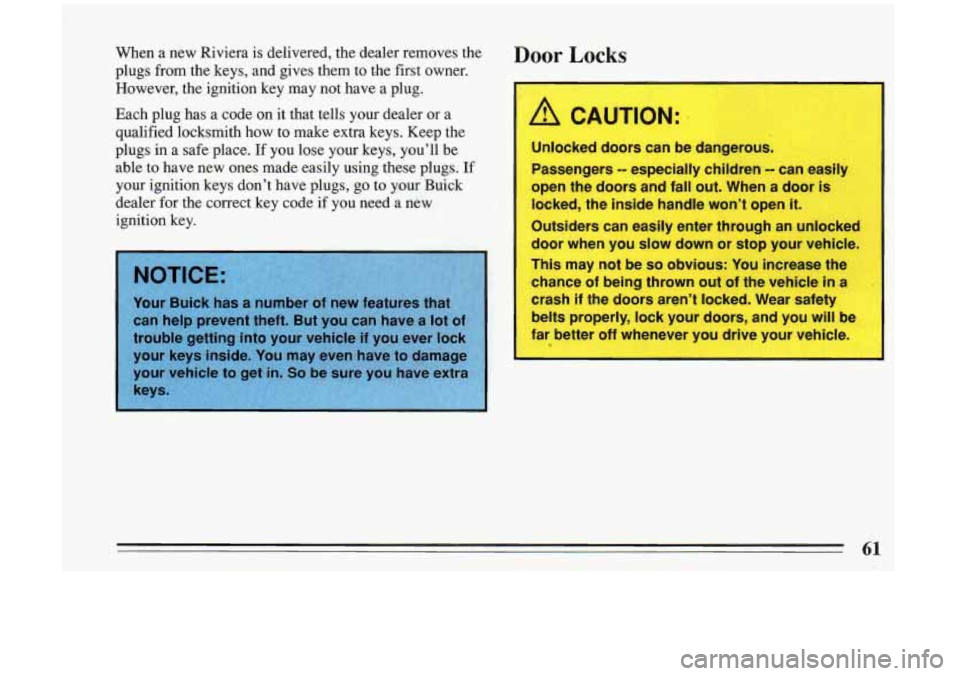
When a new Riviera is delivered, the dealer removes the
plugs from the keys, and gives them to t,he first owner.
However, the ignition key may not have a plug.
Each plug has a code
on it that tells your dealer or a
qualified locksmith how to make extra keys. Keep the
plugs in a safe place. If you lose your keys, you'll be
able to have new ones made easily using these plugs. If
your ignition keys don't have plugs, go to your Buick
dealer for the correct kev code
if you need a: new
ignition key.
Door Locks
A CAUTION:
Unlocked doors can be dangerous.
Passengers
-- especially children -- can easily
open the doors and fall out. When a
doo
locked, the inside handle won3 open it.
Outsiders can easily enter throwgh an unlocked
door when you slow down or stop your vehicle.
This may not be
so obvious: Yrou inscrease the
chance of being thrown out of the vehicle in a
crash if the doors aren't locked. Wear safety
belts properly, lock your doors, and
you will be
far better off whenever you drive your vehicle,
61
Page 68 of 324

Battery Replacement
Under normal use, the batteries in your key chain
transmitter should last about two years.
You can tell the batteries are weak if the transmitter
won't work at the normal range in any location. If you
have to get close to your vehicle before the transmitter
works, it's probably time to change the batteries.
To replace the battery, insert the round end of the door
lock key into the slot of the access door on the back
of
the transmitter. Turn the door one-sixteenth of a turn to
the left, and'lift it out
of the transmitter. Remove the
battery and replace it with a Sanyo
CR2025 or
equivalent. It is important to use the correct size battery.
Using the wrong battery may damage the transmitter.
Make sure you install the battery as the direction under
the cover indicates.
To put the cover back on, line up the
notches and turn to the right.
Theft
Vehicle theft is big business, especially in some cities.
Although your hick has a number
of theft deterrent
features, we know that nothing we put on it can make it
impossible
to steal. However, there are ways you can
help.
Key in the ignition: If you walk away from your
vehicle with the keys inside, it's an easy target for joy
riders or professional thieves
-- so don't do it.
When you park your Buick and open the driver's door, you'll hear a tone reminding you to remove your key
from the ignition and take it with you. Always do this.
Your steering wheel will be locked, and
so will your
ignition and transaxle. And remember to lock the doors.
66
Page 88 of 324
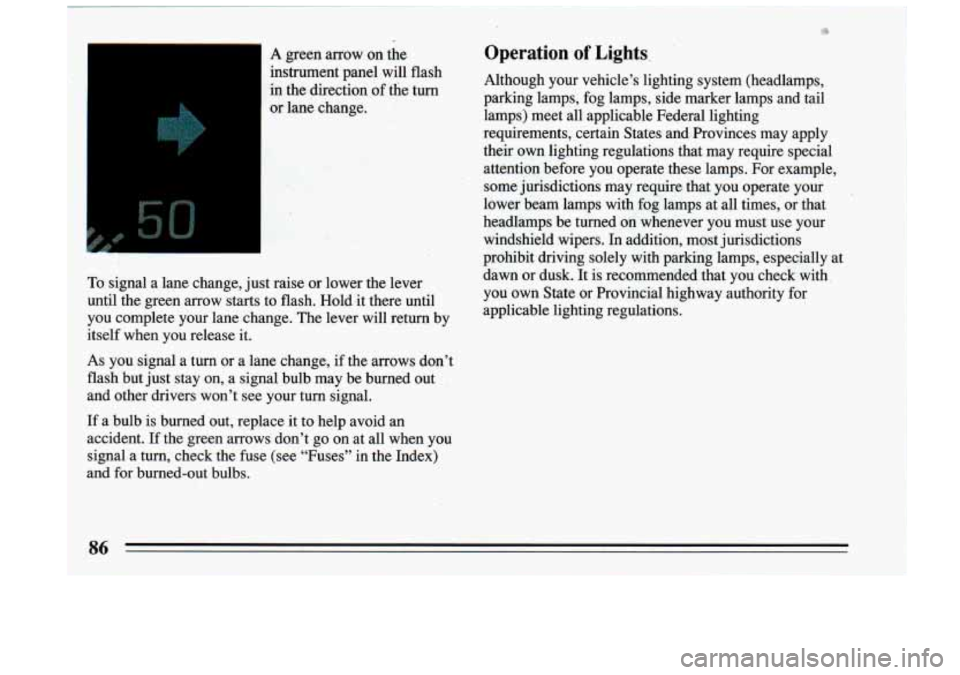
L
in the direciion of the turn
or lane change.
To signal a lane change, just raise or lower
the lever
until the green arrow starts to flash. Hold it there until
you complete your lane change. The lever will return by
itself when you release it.
As you signal a turn or a lane change, if the arrows don’t
flash but just stay on, a signal bulb may be burned out
‘and other drivers won’t see your turn signal.
Operation of Lights.
Although your vehicle’s lighting system (headlamps,
parking lamps, fog lamps, side marker lamps and tail
lamps) meet all applicable Federal lighting
requirements, certain States and Rovinces may apply
their
own lighting regulations that may require special
attention before you operate these lamps. For example,
some jurisdictions may require that you operate your
lower beam lamps with fog lamps at all times, or that
headlamps be turned on whenever you must use your
windshield wipers. In addition, most jurisdictions
prohibit driving solely with parking lamps, especially at
dawn or dusk. It is recommended that you check with you own State or Provincial highway authority
for
applicable lighting regulations.
1
If a bulb is burned out, replace it to help avoid an
accident.
If the green arrows don’t go on at all when you
signal a turn, check the fuse (see “Fuses” in the Index)
hnd-fQr bumed-Qvt bulbs. i
3
Page 126 of 324
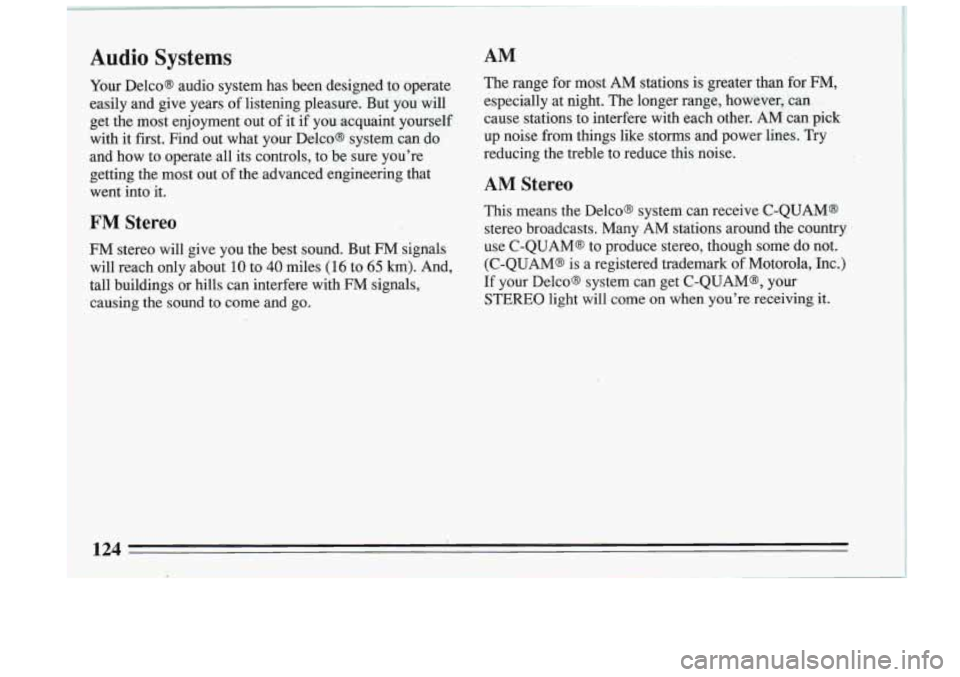
Audio Systems
Your Delco@ audio system has been designed to operate
easily and give years
of listening pleasure. But you will
get the most enjoyment out of it if you acquaint yourself
with it first. Find out what your DelcoQ system can
do
and how to operate all its controls, to be sure you’re
getting the most out of the advanced engineering that
went into it.
FM Stereo
FM stereo will give you the best sound. But FM signals
will reach only about
10 to 40 miles (16 to 65 km). And,
tall buildings or hills can interfere with FM signals,
causing the sound
to come and go.
AM
The range for most AM stations is greater than for FM,
especially at night. The longer range, however, can
cause stations to interfere with each other. AM can pick
up noise from things like storms and power lines. Try
redu
~ --lg the treble to reduce this noise.
AM Stereo
This means the Delcoa system can receive C-QUAM@
stereo broadcasts. Many AM stations around the country
use C-QUAM@ to produce stereo, though some do not.
(C-QUAM@ is
a registered trademark of Motorola, Inc.)
If your Delcoa system can get C-QUAM@, your
STEREO light will come on when you’re receiving it.
I 124 I
! I
Page 129 of 324
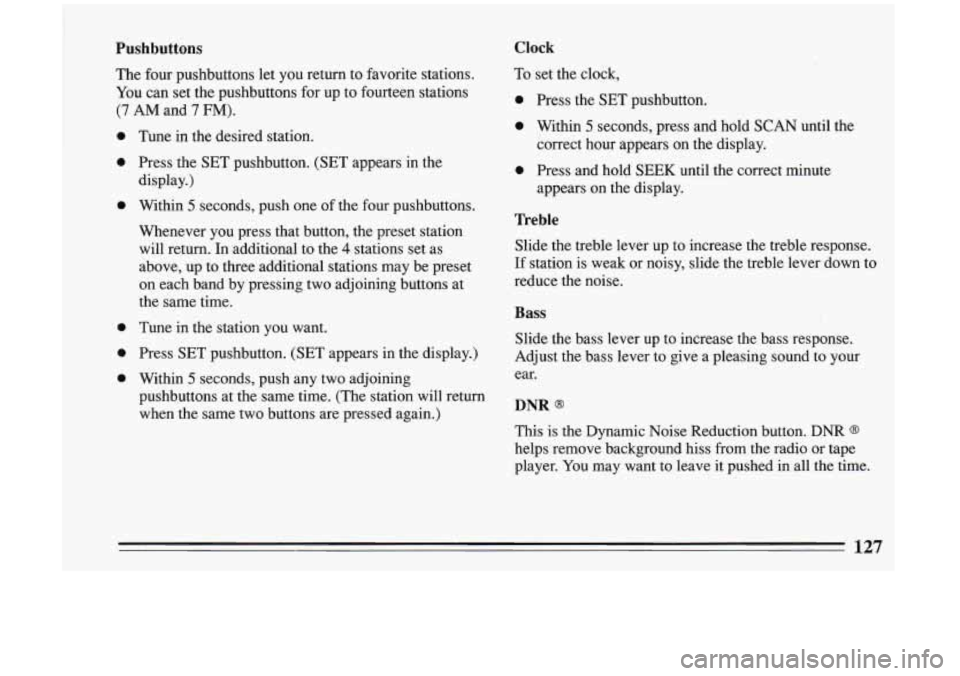
Pushbuttons
The four pushbuttons let you return to favorite stations.
You can set the pushbuttons for up to fourteen stations
(7 AM and 7 FM).
0
0
0
0
0
0
Tune in the desired station.
Press the SET pushbutton. (SET appears in the
display.)
Within
5 seconds, push one of the four pushbuttons.
Whenever you press that button, the preset station
will return. In additional to the
4 stations set as
above, up to three additional stations may be preset
on each band by pressing two adjoining buttons at
the same time.
Tune in the station you want.
Press SET pushbutton. (SET appears in the display.)
Within
5 seconds, push any two adjoining
pushbuttons at the same time. (The station will return
when the same two buttons are pressed again.)
Clock
To set the clock,
0 Press the SET pushbutton.
0 Within 5 seconds, press and hold SCAN until the
0 Press and hold SEEK until the correct minute correct hour appears on
the display.
appears on the display.
Treble
Slide the treble lever up to increase the treble response.
If station is weak or noisy, slide the treble lever down to
reduce the noise.
Bass
Slide the bass lever up to increase the bass response.
Adjust the bass lever to give a pleasing sound to your
ear.
DNR Q
This is the Dynamic Noise Reduction button. DNR Q
helps remove background hiss from the radio or tape
player. You may want to leave
it pushed in all the time.
127
Page 153 of 324

“I’ll be careful” isn’t the right answer. What if there’s an
emergency, a need to take sudden action, as when a
child darts into the street?
A person with a higher BAC
might not be able to react quickly enough to avoid the
collision.
There’s something else about drinking and driving that
many people don’t know. Medical research shows that
alcohol in a person’s system can make crash injuries
worse. That’s especially true for brain, spinal cord and
heart injuries. That means that
if anyone who has been
drinking
-- driver or passenger -- is in a crash, the
chance of being killed
or permanently disabled is higher
than
if that person had not been drinking. And we’ve
already seen that the chance of a crash itself is higher for
drinking drivers.
151
Page 162 of 324
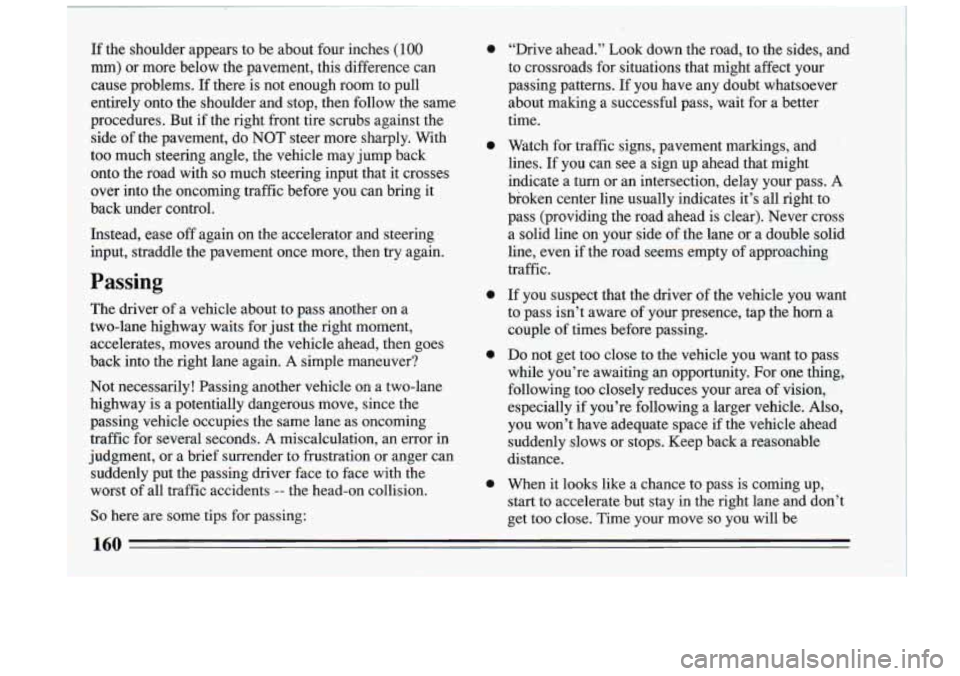
If the shoulder appears to be about four inches (100
mm) or more below the pavement, this difference can
cause problems.
If there is not enough room to pull
entirely onto the shoulder and stop, then follow the same
procedures. But if the right front tire scrubs against the
side of the pavement, do NOT steer more sharply. With
too much steering angle, the vehicle may jump back
onto the road with
so much steering input that it crosses
over into the oncoming traffic before you can bring it
back under control.
Instead, ease off again on the accelerator and steering
input, straddle the pavement once more, then try again.
Passing
The driver of a vehicle about to pass another on a
two-lane highway waits for just the right moment,
accelerates, moves around the vehicle ahead, then goes
back into the right lane again. A simple maneuver?
Not necessarily! Passing another vehicle on a two-lane
highway is a potentially dangerous move, since the
passing vehicle occupies the same lane as oncoming
traffic for several seconds. A miscalculation, an error
in
judgment, or a brief surrender to frustration or anger can
suddenly put the passing driver face to face with the
worst of all traffic accidents
-- the head-on collision.
So here are some tips for passing:
0
0
0
0
0
“Drive ahead.” Look down the road, to the sides, and
to crossroads for situations that might affect your
passing patterns. If you have any doubt whatsoever
about making a successful pass, wait for a better
time.
Watch for traffic signs, pavement markings, and
lines.
If you can see a sign up ahead that might
indicate a turn or an intersection, delay your pass.
A
broken center line usually indicates it’s all right to
pass (providing the road ahead
is clear). Never cross
a solid line on your side of the lane or a double solid
line, even
if the road seems empty of approaching
traffic.
If you suspect that the driver of the vehicle you want
to pass isn’t aware of your presence,, tap the
horn a
couple of times before passing.
Do not get too close to the vehiclc 3u want to pass
while you’re awaiting an opportunny. For one thing, following too closely reduces your area of vision,
especially
if you’re following a larger vehicle. Also,
you won’t have adequate space
if the vehicle ahead
suddenly slows
or stops. Keep back a reasonable
distance.
~~
When it looks like a chance to pass is coming up,
start to accelerate but stay in the right lane and don’t
get too close. Time your move
so you will be
160